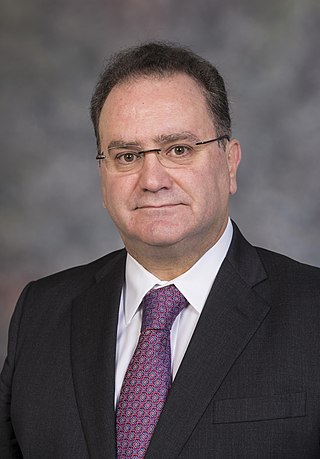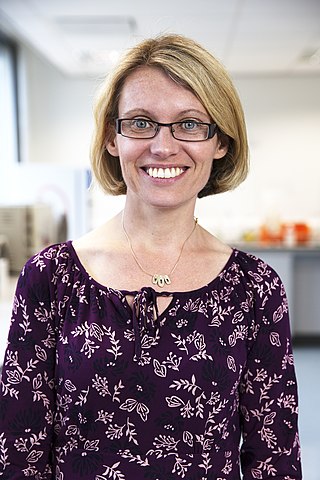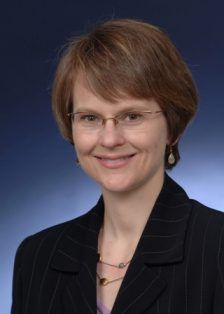Related Research Articles

The American Chemical Society (ACS) is a scientific society based in the United States that supports scientific inquiry in the field of chemistry. Founded in 1876 at New York University, the ACS currently has more than 155,000 members at all degree levels and in all fields of chemistry, chemical engineering, and related fields. It is one of the world's largest scientific societies by membership. The ACS is a 501(c)(3) non-profit organization and holds a congressional charter under Title 36 of the United States Code. Its headquarters are located in Washington, D.C., and it has a large concentration of staff in Columbus, Ohio.

Robert Howard GrubbsForMemRS was an American chemist and the Victor and Elizabeth Atkins Professor of Chemistry at the California Institute of Technology in Pasadena, California. He was a co-recipient of the 2005 Nobel Prize in Chemistry for his work on olefin metathesis.

Tungsten oxytetrafluoride is an inorganic compound with the formula WOF4. It is a colorless diamagnetic solid. The compound is one of many oxides of tungsten. It is usually encountered as product of the partial hydrolysis of tungsten hexafluoride.
Thin-film composite membranes are semipermeable membranes manufactured to provide selectivity with high permeability. Most TFC's are used in water purification or water desalination systems. They also have use in chemical applications such as gas separations, dehumidification, batteries and fuel cells. A TFC membrane can be considered a molecular sieve constructed in the form of a film from two or more layered materials. The additional layers provide structural strength and a low-defect surface to support a selective layer that is thin enough to be selective but not so thick that it causes low permeability.
Small-angle X-ray scattering (SAXS) is a small-angle scattering technique by which nanoscale density differences in a sample can be quantified. This means that it can determine nanoparticle size distributions, resolve the size and shape of (monodisperse) macromolecules, determine pore sizes, characteristic distances of partially ordered materials, and much more. This is achieved by analyzing the elastic scattering behaviour of X-rays when travelling through the material, recording their scattering at small angles. It belongs to the family of small-angle scattering (SAS) techniques along with small-angle neutron scattering, and is typically done using hard X-rays with a wavelength of 0.07 – 0.2 nm. Depending on the angular range in which a clear scattering signal can be recorded, SAXS is capable of delivering structural information of dimensions between 1 and 100 nm, and of repeat distances in partially ordered systems of up to 150 nm. USAXS can resolve even larger dimensions, as the smaller the recorded angle, the larger the object dimensions that are probed.

Egbert (Bert) Willem Meijer is a Dutch organic chemist, known for his work in the fields of supramolecular chemistry, materials chemistry and polymer chemistry. Meijer, who is distinguished professor of Molecular Sciences at Eindhoven University of Technology (TU/e) and Academy Professor of the Royal Netherlands Academy of Arts and Sciences, is considered one of the founders of the field of supramolecular polymer chemistry. Meijer is a prolific author, sought-after academic lecturer and recipient of multiple awards in the fields of organic and polymer chemistry.
Amit Chakrabarti is the former William and Joan Porter Chair in Physics at Kansas State University. He currently serves as the dean of the college of arts and sciences at Kansas State University.
Molly S. Shoichet, is a Canadian science professor, specializing in chemistry, biomaterials and biomedical engineering. She was Ontario's first Chief Scientist. Shoichet is a biomedical engineer known for her work in tissue engineering, and is the only person to be a fellow of the three National Academies in Canada.
Alan J. Russell, is Vice President of Biologics for Amgen, one of the world’s leading Biopharmaceutical companies. Until 2020, Alan was the Highmark Distinguished Career Professor and Director of the Disruptive Health Technology Institute at Carnegie Mellon University. From 2013 through spring of 2016 he was also the Chief Innovation Officer, Allegheny Health Network.

Transparent wood composites are novel wood materials which have up to 90% transparency. Some have better mechanical properties than wood itself. They were made for the first time in 1992. These materials are significantly more biodegradable than glass and plastics. Transparent wood is also shatterproof.

Timothy M. Swager is an American Scientist and the John D. MacArthur Professor of Chemistry at the Massachusetts Institute of Technology. His research is at the interface of chemistry and materials science, with specific interests in carbon nanomaterials, polymers, and liquid crystals. He is an elected member of the National Academy of Sciences, American Academy of Arts and Sciences, and the National Academy of Inventors.

Antonios Georgios Mikos is a Greek-American biomedical engineer who is the Louis Calder Professor of Bioengineering and Chemical and Biomolecular Engineering at Rice University. He specialises in biomaterials, drug delivery, and tissue engineering.
William B. Tolman an American inorganic chemist focusing on the synthesis and characterization of model bioinorganic systems, and organometallic approaches towards polymer chemistry. He has served as Editor in Chief of the ACS journal Inorganic Chemistry, and as a Senior Investigator at the NSF Center for Sustainable Polymers. Tolman is a Fellow of the American Association for the Advancement of Science and the American Chemical Society.

Shlomo Margel is a Professor of Chemistry at Bar Ilan University specializing in polymers, biopolymers, functional thin films, encapsulation, surface chemistry, nanotechnology, nanobiotechnology and agro-nanotechnology.

Aline Fiona Miller is a Professor of Biomolecular Engineering at the University of Manchester. She specialises in the characterisation of polymer, biopolymer and peptides, using neutron and x-ray scattering, as well as the development of functionalised nanostructures for regenerative medicine and toxicology testing.

Kathryn L. Beers is an American polymer chemist. Beers is Leader of the Polymers and Complex Fluids group in the Materials Science and Engineering Division at the National Institute of Standards and Technology. Her research interests include microreactors and microfluidics, advances in polymer synthesis and reaction monitoring, macromolecular separations, integrated and high throughput measurements of polymeric materials, degradable and renewable polymeric materials, and sustainable materials.

Jayaraman Sivaguru (Siva) is the Antonia and Marshall Wilson Professor of Chemistry and the Associate Director, Center for Photochemical Sciences at the Department of Chemistry, Bowling Green State University, Bowling Green, Ohio. He is a recipient of 2008 National Science Foundation CAREER Award, 2010 Grammaticakis-Neumann Prize from the Swiss Chemical Society, 2011 young-investigator award from the Inter-American Photochemical Society (I-APS), and 2012-young investigator award from Sigma Xi. His honors also include Excellence in Research award, 2011 Excellence in Teaching award, and the 2012 PeltierAward for Innovation in Teaching. Prof. Siaguru was a visiting young professor at the Global Centre for Excellence at Osaka University, Japan and was a visiting fellow for the Chinese Academy of Sciences President's International Fellowship Initiative in 2018. He is an editor for the Journal of Photochemistry and Photobiology A: Chemistry and from 2020 serves as the co-Editor-in-Chief of Journal of Photochemistry and Photobiology published by Elsevier. He is an international board member of the International Union of Pure and Applied Chemistry (IUPAC) photochemistry symposium.
Tatiana Budtova is a chemical researcher. She works at MINES ParisTech and specialises in the chemical physics of polymers, particularly bio-based polymers and bio-based aerogels. In 2020, she was awarded the CNRS Silver Medal.
Christine Luscombe is a Japanese-British chemist who is a professor at the Okinawa Institute of Science and Technology. Her research investigates polymer chemistry, organic electronics, organic photovoltaics and the synthesis of novel materials for processable electronics. She serves on the editorial boards of Macromolecules, Advanced Functional Materials, the Annual Review of Materials Research and ACS Applied Materials & Interfaces.
Emily D. Cranston is a Canadian chemist who is a professor at the University of British Columbia and President’s Excellence Chair in Forest Bioproducts. She investigates nanocellulose and hybrid bio-based materials. Cranston is an NSERC E.W.R. Steacie fellow and was awarded the Kavli Emerging Leader in Chemistry lectureship in 2018 and the Tappi NanoDivision Technical Award in 2021.
References
- ↑ "CV" (PDF). icbp2017tw.net. Archived from the original (PDF) on September 25, 2021. Retrieved November 27, 2017.
- ↑ "Professor". kth.se. Archived from the original on December 1, 2017. Retrieved November 27, 2017.
- ↑ "CV" (PDF). kth.se. Archived from the original (PDF) on September 3, 2013. Retrieved November 27, 2017.
- ↑ "Editor". acs.org. Retrieved November 27, 2017.